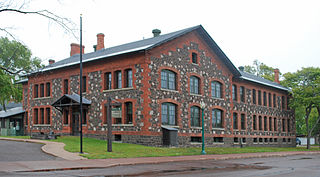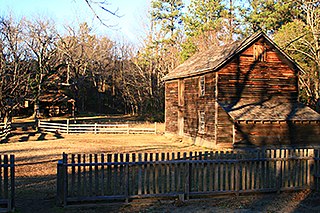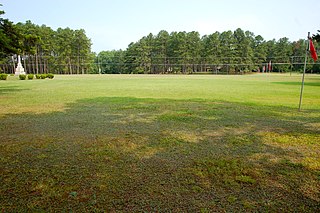
The North Carolina Transportation Museum is a museum in Spencer, North Carolina. It is a collection of automobiles, aircraft, and railway vehicles. The museum is located at the former Southern Railway's 1896-era Spencer Shops and devotes much of its space to the state's railroad history. The museum has the largest collection of rail relics in the Carolinas. Its Back Shop building of nearly three stories high is notable for its size, two football fields long.

Abraham Lincoln Birthplace National Historical Park is a designated U.S. historic park preserving two separate farm sites in LaRue County, Kentucky, where Abraham Lincoln was born and lived early in his childhood. He was born at the Sinking Spring site south of Hodgenville and remained there until the family moved to the Knob Creek Farm northeast of Hodgenville when he was two years old, living there until he was seven years of age. The park's visitor center is located at the Sinking Spring site.

Keweenaw National Historical Park is a unit of the U.S. National Park Service. Established in 1992, the park celebrates the life and history of the Keweenaw Peninsula in the Upper Peninsula of the U.S. state of Michigan. It is a federal-local cooperative park made up of two primary units, the Calumet Unit and the Quincy Unit, and almost two dozen cooperating "Heritage Sites" located on federal, state, and privately owned land in and around the Keweenaw Peninsula. The National Park Service owns approximately 1,700 acres (690 ha) in the Calumet and Quincy Units. Units are located in Baraga, Houghton, Keweenaw, and Ontonagon counties.

The Carter Family Fold is a musical performance and concert venue located near Hiltons, Virginia. It is dedicated to the preservation and performance of old time country and bluegrass music. It is named in honor of the original Carter Family, A.P., Sara, and Maybelle, who were among the earliest recording artists in country music, with their first records on RCA Victor being released in 1927. The Fold was founded by Janette Carter, daughter of A.P. and Sara Carter, in 1979.

The South Carolina Botanical Garden is located in Clemson, South Carolina on the campus of Clemson University. This garden has nature trails, pathways, ponds, streams, woodlands, trial gardens, The Bob Campbell Geology Museum, and the Fran Hanson Discovery Center, which has exhibits by local artists. It is open to the public every day of the week. The Bob Campbell Geology Museum features more than 10,000 rocks, minerals and fossils and has exhibits focused on geological and paleontological topics.

Duke Homestead State Historic Site is a state historic site and National Historic Landmark in Durham, North Carolina. The site belongs to the North Carolina Department of Natural and Cultural resources and commemorates the place where Washington Duke founded the nation's largest early-20th-century tobacco firm, the American Tobacco Company.
The North Carolina Museum of Natural Sciences (NCMNS) is a museum in Raleigh, North Carolina. The museum is the oldest in the state.
Norskedalen Nature and Heritage Center is a non-profit organization dedicated to preserving, interpreting, and sharing the Coulee Region's natural environment and cultural heritage. It is near Coon Valley, in La Crosse, and Vernon counties, Wisconsin, United States.

The Whyte Museum of the Canadian Rockies is located in Banff, Alberta, Canada. The museum collects, preserves, and exhibits materials related to the cultural heritage of the Rocky Mountains of Canada, making them available for education as well as research. The museum, which contains an archive and a library, was the inspiration of Banff artists Peter and Catharine Whyte. The Alpine Club of Canada has dedicated the Peter and Catharine Whyte Hut on the Peyto Glacier after the couple.

Founded in 1915, the Greater Los Angeles Area Council (GLAAC) (#033) served most of the City of Los Angeles as well as several other cities in the greater Los Angeles area. It was one of five Boy Scouts of America councils in Los Angeles County, California. Since its founding in 1915, the Los Angeles Area Council has brought its purpose and values to millions of youth. The Council served 54,567 youth in the Greater Los Angeles Area in 2008 alone.
The Mint Museum, also referred to as The Mint Museums, is a cultural institution comprising two museums, located in Charlotte, North Carolina. The Mint Museum Randolph and Mint Museum Uptown, together these two locations have hundreds of collections showcasing art and design from around the globe.

The Greater Sudbury Museums are a network of four small community history museums in Greater Sudbury, Ontario, Canada. Three of the four are located on heritage properties in different neighbourhoods within the city, and the fourth is located in a library facility.

Alamance Battleground is a North Carolina State Historic Site commemorating the Battle of Alamance. The historic site is located south of Burlington, Alamance County, North Carolina in the United States.

The dogtrot, also known as a breezeway house, dog-run, or possum-trot, is a style of house that was common throughout the Southeastern United States during the 19th and early 20th centuries. Some theories place its origins in the southern Appalachian Mountains. Some scholars believe the style developed in the post-Revolution frontiers of Kentucky and Tennessee. Others note its presence in the South Carolina Lowcountry from an early period. The main style point was a large breezeway through the center of the house to cool occupants in the hot southern climate.

The Erland Lee (Museum) Home is a National Historic Site of Canada located on the ridge of the Niagara Escarpment in Stoney Creek, Hamilton, Ontario. Originally a farmhouse belonging to Erland and Janet Lee, the museum is recognized as the birthplace of the first Women's Institute, an international organization formed in 1897 to promote the education of isolated rural women.
James Kenneth "J.K." Ralston was an American painter of the Old American West whose primary topics were the American West and images of cowboys and American Indians. He also did commercial artwork.

The Mineral and Lapidary Museum of Henderson County is a non-profit, volunteer-run museum in Hendersonville, North Carolina, United States, founded in 1997 at 400 North Main Street in the middle of the city's Historic District.
The Civil War Trust's Civil War Discovery Trail is a heritage tourism program that links more than 600 U.S. Civil War sites in more than 30 states. The program is one of the White House Millennium Council's sixteen flagship National Millennium Trails. Sites on the trail include battlefields, museums, historic sites, forts and cemeteries.

The State Archives of North Carolina, officially the North Carolina Division of Archives and Records, is a division of North Carolina state government responsible for collecting, preserving, and providing public access to historically significant archival materials relating to North Carolina, and responsible for providing guidance on the preservation and management of public government records to state, county, city and state university officials. First founded as the North Carolina Historical Commission in 1903, the State Archives has undergone multiple changes in organization, title, and relation to other state agencies. Since May 2012, it has been known as the Division of Archives and Records within the North Carolina Department of Natural & Cultural Resources' Office of Archives and History.













